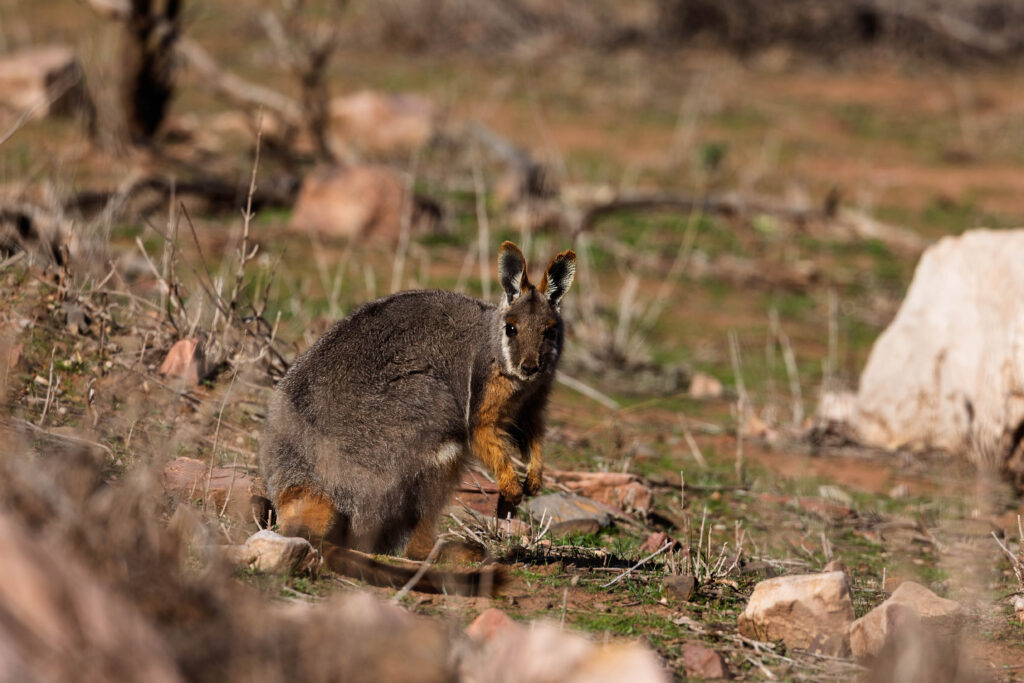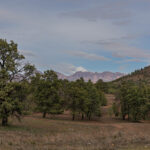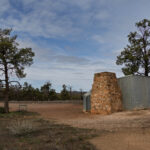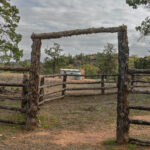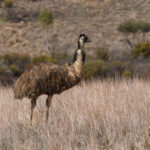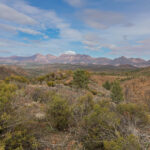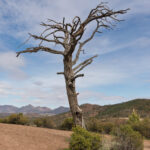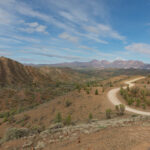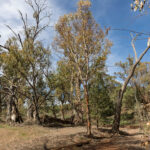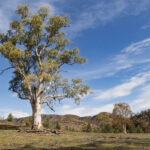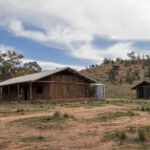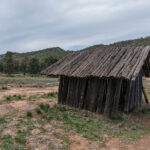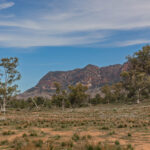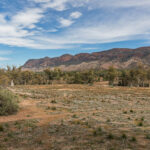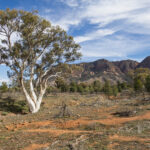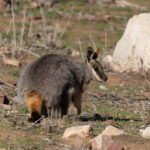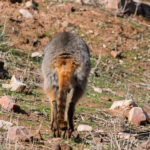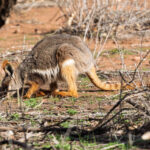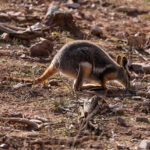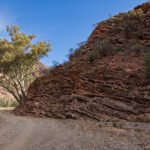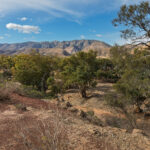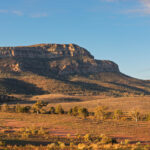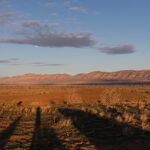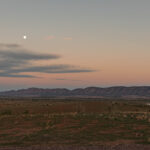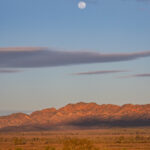Friday, 8 August 2025
The weather is still treating us well. Not as clear as Tuesday and Wednesday but less cloudy than yesterday which is good. Always lovely to have some blue sky for our photos.
An easier day today driving through the gorges. We set out north along the Flinders Ranges Way. Today we drove past the turn off to Wilpena Pound before taking a left onto Bunyeroo Road. Our first stop was at Yanyanna Hut and stockyard. This was a central point in the Aroona pastoral run so a good location for a rudimentary hut for drovers. The current iron structure dates from 1937 and is available as an overnight shelter for hikers undertaking the Heysen Trail.
Leaving the hut we encountered a mob of emus. We’re accustomed to seeing emus in pairs or family groups and have never seen such a large group before. Google tells me that emus are not particularly social birds but they do form mobs when feeding or travelling. We watched them feeding on the side of the road for too long because a couple got spooked and cavorted across the road. Oh, no, emus on the road is bad news because there is no way to know what the silly things will do … will they all start stampeding across/along the road?? We waited for a while as more and more decided that they would cross the road, but still there were stragglers on the original side of the road. Eventually Bernie edged the truck forward, very slowly, and we made it past the emus without hitting any.
We arrived at Bunyeroo Valley Lookout, where we enjoyed the amazing view and shortly after, Razorback Lookout, with another outstanding vista. At Bunyeroo Gorge we parked in the car park and clambered down to the creek bed for a better look at the gorge. The road meanders through the gorge, alongside and at time across or along the creek amongst the ubiquitous river red gums.
At the Bunyeroo Car Park we walked into a different section of the gorge along the Brachina Gorge Geological Walking Trail. Although we were driving the 20-kilometre driving trail, there is also an eight kilometre walking trail. We walked about ten minutes in to observe some of the geology more closely than was possible on the road. This area is considered to have one of the best records in the world of sedimentary deposition in the period between 800 million and 500 million years ago and is described as – a corridor through time. The way that the originally horizontal layers have been forced upwards over time creates spectacular scenery.
We made a right turn at Brachina Gorge Road, stopped briefly at the Aroona Valley Lookout, before driving out the Aroona Road to the Aroona Homestead Heritage Site. We made ourselves a picnic lunch before exploring the remains of Pumpa’s Hut and the ruins of the Aroona Homestead.
When European explorers found a natural spring here at Aroona the area’s first pastoralist, Johnson Frederick Hayward, soon followed in 1851. He built the homestead in 1854 and enjoyed 15 years of profitable sheep farming before returning to England in 1862 a rich man. In the years following, small pastoral properties such as Aroona were devastated by drought. With the springs being an important resource for the Adnyamathanha people the arrival of the settlers changed their lives forever.
Pumpa’s Hut was built in 1925 and occupied for many years by Eddie and Rose Pumpa and their family. Eddie and Rose hosted renowned Australian artist, Hans Heyson, here in 1927 when he made studies for landscapes that he would later finish in his studio at Hahndorf.
We drove back out to the Brachina Gorge Road and turned right to head towards The Outback Highway. Before reaching the highway we had to negotiate the spectacular Brachina Gorge. We stopped in the gorge at the rock scree that is home to a colony of yellow-footed rock-wallabies. The signs suggested staying quiet and watching carefully to try to see one of these incredibly well-camouflaged marsupials. Soon after we arrived we spotted three hopping across the face of the scree but they soon disappeared into the scrub at the side. They move so quickly on such loose footing!
A local wandered back up to the road, the owner of the only other car in the car park. He shared with Bernie that there were two wallabies grazing on the grass nearer the river. OK, not on the rocks then, 180 degrees from where we were squinting up into the sun trying to see them on the rock scree, ha, ha. We quietly, quietly made our way along the road to try to see the wallabies. In the end we were lucky enough to see four of these beautiful little rock hoppers. Well, maybe only three as we might have seen one of them twice??
We continued through the gorge and then out of the National Park turning northward when we reached the highway. We were only able to enjoy the bitumen road for a short distance, turning back onto the unmade road at Parachilna, to make our way through Parachilna Gorge. We both felt that after Brachina Gorge that Parachilna Gorge was a bit … underwhelming. In our opinion if someone travelling to the Flinders Ranges only has time to do one gorge drive, then they should definitely choose to drive through the Bunyeroo Gorge and Valley and Brachina Gorge.
We stopped at the Angorichina Village which consists of a camping and caravan park, some cabins and a general store. Bernie was curious to check it out, so purchased an icy-pole, a packet of chips and a coke just to be able to say he’s been to the shop at Angorichina. The proprietor had the cheek to comment about his ‘healthy’ food and beverage purchase!! Bernie was impressed though that their petrol pump was offering 98–octane unleaded fuel. Otherwise, the whole set up was pretty unremarkable.
We passed through Blinman to return to Rawnsley Park via Flinders Ranges Way. We will be heading this way again in a day or two so we didn’t stop at any of the lookouts. Well, that, and the fact that it was getting late in the afternoon and there were too many jumping marsupials grazing beside the road. We wanted to get back ‘home’ before the sun dropped any lower in the sky, making an unfortunate encounter with wildlife an increasingly higher possibility.
It was with relief that turned into the Rawnsley Park drive. With it now getting very close to sunset we drove past our cabin to the Station Hill Lookout to watch the sun go down. Apparently this is more dramatic in the summer when the setting sun makes the Red Terraces glow even more red. It was still quite spectacular this evening with the near full moon rising above the Chace and Elder Ranges and the sun setting over Wilpena Pound.
Steps: 11,057 (7.38kms)



